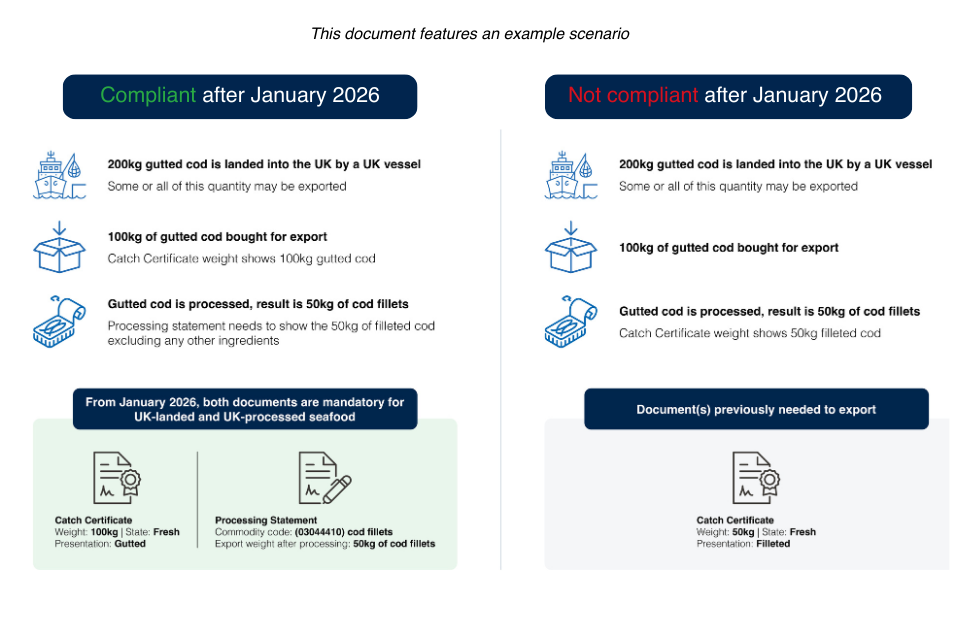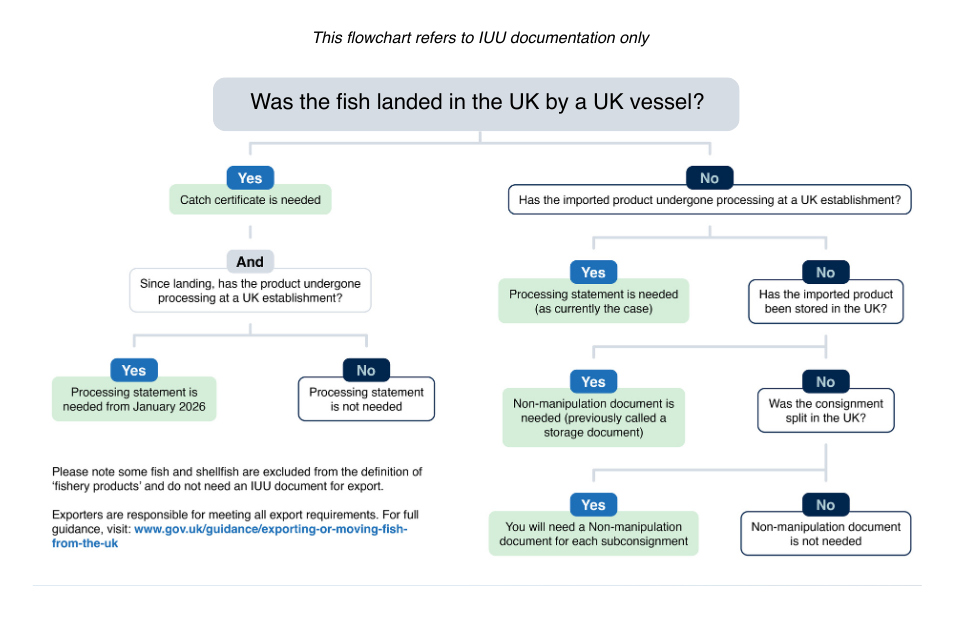EU IUU Regulation Changes 2026: Catch Certificate & other documentation updates
New EU Illegal, Unreported, and Unregulated fishing (IUU) requirements mean that UK exporters will need to provide additional information on catch certificates and other IUU documents from 10 January 2026. The changes detailed below have been incorporated into the catch certificate application. Exporters of fishery products should familiarise themselves with the updated requirements to ensure continued compliance and avoid delays or rejections at border control points when these changes become mandatory in January 2026.
New requirement:
If you export products that have been caught by a UK vessel and processed in the UK after landing from January 2026, these consignments will require both a catch certificate AND a processing statement. Please see the guidance below for more information.
During this initial period, the new fields will be optional to complete. This phased approach is designed to give exporters time to become familiar with the information they will need to provide once the requirements become mandatory in January 2026.
The new requirements are as follows
NEW: UK catch certificate and UK processing statements
From January 2026, if the fish was landed in the UK and processed after landing in the UK, the consignment must be accompanied by a catch certificate for the landed weight that is being exported AND a processing statement referencing that catch certificate.
This guidance is being published in advance to help users prepare for the change. Until January 2026, exporters of UK-landed and UK-processed fish are not yet required to complete a processing statement but should begin familiarising themselves with this new requirement to ensure compliance once this becomes mandatory.
The weight on the UK Catch Certificate must reflect the weight, state and presentation of the fish being exported that was landed by the vessel. This does not need to be the total landed weight if only part of that landing is being exported. The accompanying processing statement must reference the catch certificate and the processed weight of the product being exported.
New requirements for UK-landed and processed fish exports

UK Catch Certificate updates
Fishing Trip Dates
From January 2026, in addition to the existing requirement to provide the date the fishery product was landed, exporters will also need to provide the start date of the fishing trip that each species was caught on.
- Start date of fishing trip – This is the date the vessel left port on the trip the fish was landed. In the case of store pots, the start date will be the date the vessel left port to collect the pots, NOT the date the pots were deployed.
- Date Landed - The date the catch was landed (or the first day landing begins where this is not completed within a single day).
Gear Type
From January 2026, exporters will need to provide the category of gear and the type of gear within that category, used to catch each fishery product. There will be a predefined list provided for exporters to select the gear category and type from. See below a button to the FAO gear types and categories:
Catch Areas
Currently, exporters are required to provide the FAO area in which each species within a consignment was caught. From January 2026, there will be new requirements to give more specific information about the catch area for each product, including:
- The Exclusive Economic Zone (EEZ) in which the species was caught
- If the catch did not occur within an EEZ, confirmation whether it was caught in the high seas
- Confirmation whether the species, and the area it was caught in, is covered by a Regional Fisheries Management Organisation (RFMO) where applicable.
These additional fields will appear in the application on a optional basis from July 2025, to help users prepare for the mandatory requirement in January 2026.
The definition of these three new requirements is as follows
- Exclusive Economic Zone (EEZ) - EEZs extend out to 200 nautical miles (nm) from the coastline or a median line where it meets another country’s limits. Within EEZs the coastal state has sovereign rights to exploration and exploitation of the natural resources, marine research and responsibility for protection and preservation of Marine life.
- High Seas Area - high seas are international marine waters outside the jurisdiction of any country beyond the 200nm limit of the EEZ.
- Regional Fisheries Management Organisations (RFMO) - RFMOs are international organisations establishing binding measures for conservation and sustainable management of highly migratory or straddling fish species.
Transport details
There are new requirements regarding the transport details included on the catch certificate:
- From January 2026, the exporter will be responsible for filling in the details of the first transport from point of export included in the Appendix to the EUs updated catch certificate template, indicating the port or place of departure and the means of transport. This section will not be applicable for direct landing applications
- This section cannot be left blank
- Exporters can provide the details known to them at the time of creating the catch certificate if the transport from the point of export is not known.
- Where additional modes of transport are known, these can be added manually to the catch certificate. If no further transport details are known by the exporter at the point of creating the catch certificate the importer can be requested to provide it.
- The point of destination must also be included on the catch certificate.
- If the point of destination is not known when creating a catch certificate, the first point of entry into the EU can be used.
Appearance
Various cosmetic changes will be made to the catch certificate for the UK template to comply with the new EU requirements. These are mainly updates to the certificate layout and information included in the catch certificate PDF. These amends will not have an impact on the application screens for the exporter when creating a catch certificate.
Note: It is intended these PDF changes will be applied before January 2026 and the exact timing will be communicated closer to the update.
If you choose to enter information in any of the new optional fields before these changes are applied, the data will be securely stored, but it will not appear on the PDF certificate until the new format is introduced. Any PDF certificates generated before that point will not include this optional information, even if it has been entered.
These cosmetic changes include:
- Section 2 - The IMO/Unique vessel identifier (where applicable) - this field will be auto populated
- Section 7 - Transhipment and/or landing authorisation into port area. This section is for completion by the importing country’s authorities. It will not appear in the application screens for UK exporters.
- Sections 11 - Importer Declaration. Several new fields will be added to the PDF version of this section. This section is to be completed by the importer when the consignment arrives at its destination.
- Section 12 - Import Control: Authority. This section is to be completed by the importing authority and does not affect the exporter’s application
- Section 13 - Refusal of a catch certificate. This section is used by the importing authorities if a consignment is refused at the point of import
Data Upload Journey
As part of the changes, exporters that use the data upload facility will need to amend their csv files to incorporate the start date, fishing area and gear type changes as detailed above.
These changes will be added incrementally with further communications provided as each change is made.
The service will continue to accept the current file structure until the end of 2025. Additional guidance on data upload will be provided in due course.
Original csv file structure:
Product ID / Date landed / Catch area / Vessel PLN / Export weight (For example: PRD123,01/01/2021,FAO27,PH1100,50.95)
See below the new file structure that includes the new fields required by the EU.
New CSV File Structure from September 2025:
Use this structure for each row:
Product ID / Start date / Date landed / Catch area / High Seas area / EEZ / RFMO / Vessel PLN / Gear type / Export weight
For further guidance please see:
UK processing statement & UK storage document updates
The UK processing statement is being updated to reflect changes in EU regulations and UK export control requirements. You can find the latest updates here:
UK processing statement updates
There are additional updates to the UK storage document. From 10 January 2026, it will be renamed the Non-Manipulation Document, and a new version of the document template will be introduced. You can find the latest updates here:
Which IUU documents are required for exporting fisheries products?

Updates to this page
-
Summary updated.
-
Page title changed from EU IUU Regulation 2026 Changes to EU IUU Regulation Changes 2026: Catch Certificate & other documentation updates
-
Update 01/09
-
Monday 30 June 2025 update.
-
First published.